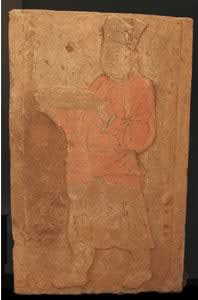Painted Relief Panel Depicting a Chef, 960 CE - 1279 CE
Stone
21
H.659
The Sung (Song) Dynasty partially reunified China after a period of chaotic turmoil following the fall of the T’ang. Historically, the Sung are noted for their revival of the ancient...
The Sung (Song) Dynasty partially reunified China after a period of chaotic turmoil following the fall of the T’ang. Historically, the Sung are noted for their revival of the ancient Confucian beliefs, ushering a period known as Neo-Confusianism that would dominate Chinese (and later on Japanese) thought for the next several centuries. Although best known for their philosophical contributions, this panel, rendered in low relief, attests to the rich artistic tradition that flourished under the enlightened rulers of the Sung Dynasty. Discovered buried inside a tomb, this gorgeous rectangular panel depicts an elegantly dressed chef presenting his latest dish fresh from the kitchen. The culinary arts of China are the oldest and most sophisticated in the world. Cooking was considered an art form as early as the 5th century B.C. when the earliest etiquette texts were written. The noble dress of this chef, including the black headdress and red tunic, reflects his honored position within the courtly entourage. He appears to be walking, as if caught in the act of delivering this meal to the table. We can almost imagine the fragrant aromas tantalizing our noses as our appetites are whetted. Although we cannot know who this chef was, we can assume that he worked on the staff of the noble elite, for only such high-ranking members of society could command such extravagant burial rites. Most likely, this stone panel was specifically commissioned for the sole purpose of accompanying the deceased into the afterlife, thereby reflecting both the wealth of the deceased as well as the familial piety of his ancestors. Thus, this divine meal was not meant for human consumption, but serves as a symbol of the celebratory feasts that await our spirits in heaven.



